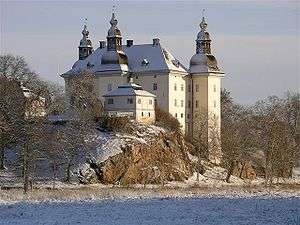Ekenäs Castle
Ekenäs Castle (Ekenäs slott in Swedish) is a castle located outside Linköping in Linköping Municipality, Östergötland, Sweden. The castle consists of a three-story main building with a high steep roof and three square towers featuring Baroque tower domes. The present castle was built in the 17th century on top of the foundations of a medieval fortress from the 14th century. The lake surrounding the castle hill created a natural defense; however, this was drained in the late 19th century to create more arable land in the area. [1]


Ownership
The castle is, and has always been, a privately owned castle. Its ownership can be traced back to Svante Sture (1517-1567) who lived during the reign of King Erik XIV, ruler of Sweden from 1560-1568. When King Erik XIV ascended the throne, he set about to win the favor of influential people in the Swedish aristocracy. One of his strategies toward that end was to bestow on three of Sweden most powerful nobles the title of 'count', an unprecedented move in Swedish history. One of the recipients of the title was Svante Sture. One of the first things Svante Sture did to exhibit his new-found status was built a stone house in 1592 on the site of the Ekenäs Castle.[2][3]
Per Gustafsson Banér (1588–1644) rebuilt the castle in Renaissance style between 1630 and 1644. He was the son of Kristina Sture, daughter of Svante Sture. The castle was owned almost continuously by his family until 1880. [4]
Some time in the early 1880s, count Philip O L Klingspor (1845-1924) acquired the castle and its surrounding area. That marked a new era in the castle's history. The castle went from a citadel to a center of farming and forestry business. [5]
The castle's current owners are the Bergengren family. The Bergengrens, who were earlier in the textile manufacturing business, bought Ekenäs in 1939. When they took over the castle, it had been unused for several years. The castle, in fact, hasd long been derelict. It is the surrounding area, totaling 1200 acres, that is more valuable. It was this combination of rich soil and ample forests that motivated the Bergengrens to buy the castle.[2]
World War II
During World War II, the Ekenäs Castle reverted, to an extent, to its original function as a defensive fortress. The castle became the local military headquarters and supply dump during the War. After the War ended the castle fell into a state of disrepair and neglect. The castle's furnishings were pillaged continuously by locals. Respite from exploitation came for the castle in 1974, when the Swedish authorities recognized it as a site of national cultural importance. After this governmental recognition, the castle was significantly restored by its owners. Its present condition had led to its being regarded as the best preserved renaissance castle in Sweden. The interior of the castle has been immaculately preserved, with its furnishing, decoration and carpentry dating back three centuries kept in a wonderful state.[2]
Visitors are welcome year-round, however, the castle itself is only open during the summer. A jousting tournament and Medieval festival has been held here in May/June every year since 1993.[6]
References
- "Ekenäs Slott, Renaissance castle". guidebook-sweden.com. Retrieved December 1, 2019.
- "Ekenäs Castle". Retrieved 26 July 2013.
- "Svante Sture". Svenskt biografiskt lexikon. Retrieved December 1, 2019.
- "Per Banér". Svenskt biografiskt lexikon. Retrieved December 1, 2019.
- "Philip O L Klingspor". Svenskt biografiskt lexikon. Retrieved December 1, 2019.
- Małgorzata Mizerska-Wrotkowska (20 July 2015). Poland and Sweden in the United Europe. SCHEDAS. pp. 152–. ISBN 978-84-943391-8-9.
External links
| Wikimedia Commons has media related to Ekenäs Castle. |